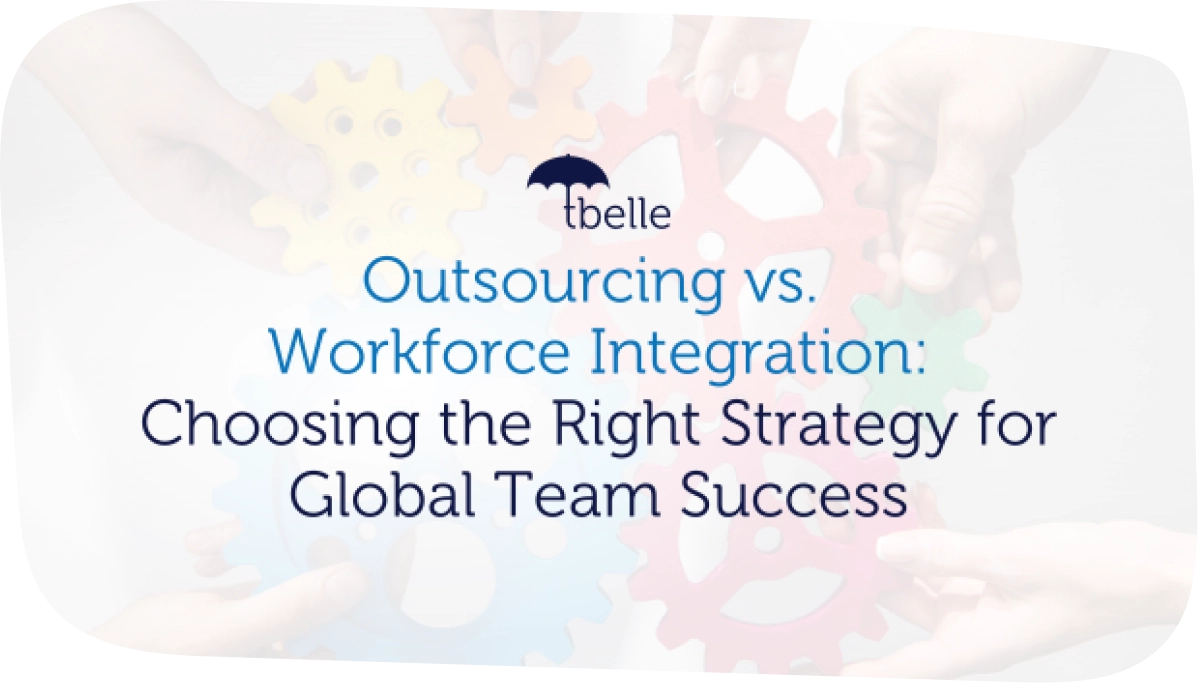The outsourcing industry is expected to grow, yet global competition and technological advancements are pushing businesses to reconsider their workforce strategies. Traditional outsourcing, while popular for cost savings, poses significant challenges such as disconnection, inequality in benefits, and cultural misalignment.
In contrast, workforce integration, which treats global teams as core parts of the organization, offers enhanced collaboration, equal access to benefits, improved morale, and better alignment with company goals. This article explores a comparative review of traditional outsourcing vs integrated workforce. As businesses seek to stay competitive, transitioning from outsourcing to workforce integration can lead to long-term success by creating a cohesive and motivated workforce.
Table of Contents

The outsourcing industry has become a significant player in the global economy with a projected CAGR of 8.9% from 2024 to 2033. Despite this trend, it has also been reported that global competition threatens to undercut its growth. Especially with the continuous advancements in technology and process improvements, businesses are increasingly seeking alternative strategies to scale their workforce and proactively address the challenges posed by global competition.
This concept signals a growing recognition that traditional outsourcing may no longer be the most effective approach to building resilient and innovative teams in today’s dynamic business environment. Choosing the right strategy to manage your workforce, especially your global team, is highly critical.
While traditional outsourcing remains a popular choice, more companies are now exploring the benefits of fully integrating their global teams into their core operations. Let us explore the key differences between outsourcing specific tasks to a global team versus fully integrating that team into the organization, highlighting the potential negative impacts of traditional outsourcing and the advantages of workforce integration.
Understanding Outsourcing and How it Works
Outsourcing refers to the practice of contracting out specific business processes or tasks to external service providers, often in different geographic locations. Outsourcing became a popular business strategy in the 1990s, with multinationals relying on third parties for logistics, manufacturing, and other functions. These tasks can range from customer support and IT services to manufacturing and payroll processing. Outsourcing allows companies to focus on their core competencies while leveraging the expertise of specialized teams elsewhere.
In Australia, outsourcing has been widely adopted across various industries, with companies seeking to reduce operational costs, increase efficiency, and access a broader talent pool. According to a report by IBISWorld, the Australian outsourcing industry has seen steady growth with a CAGR of 0.3% for the past five years. However businesses face intense competition, both domestically and internationally, driving price competition within the industry.
Motivations for Outsourcing
One of the primary reasons companies choose to outsource is to reduce operational costs while accessing specialized skills. By outsourcing tasks to countries with lower labor costs, companies can achieve significant savings, allowing them to allocate resources more effectively to global talents. This enables them to tap into specialized skills and expertise that may not be readily available in their local market.
In addition, outsourcing allows businesses to scale their operations up or down quickly, and lets them focus on their core business functions. This flexibility is particularly valuable for companies facing fluctuating workloads or seasonal demand. SImilarly, companies can also focus on their primary business objectives, when they outsource their non-core tasks.
Workforce Integration: The New Global Business Strategy

Workforce integration, on the other hand, involves incorporating global teams into the core operations of a company, treating them as an extension of the in-house team rather than as an external service provider. This approach fosters a more cohesive and collaborative working environment, where all team members, regardless of their location, are aligned with the company’s goals, values, and culture.
How Workforce Integration Stands Out
Workforce Integration distinguishes itself by transforming employee onboarding, engagement, experience, and management through a more meaningful and holistic approach. Unlike traditional methods, it immerses new hires in the company’s culture and values from the start, creating a strong sense of belonging and alignment.
This strategy extends beyond mere onboarding, encompassing the entire employee journey, including development and retention. It also involved engagement initiatives focused on fostering deeper connections among employees rather than superficial activities.
Benefits of Workforce Integration
Integrating global teams into the core operations of a company, like allowing team members to access the same policies, tools, resources, and information, promotes better communication and collaboration. In this way, it becomes easier for the team to work together towards common objectives regardless of locations and cultural backgrounds.
Workforce integration ensures that all employees, regardless of their location, have equal access to the company’s culture, benefits, and opportunities for growth.
In a study produced by the National Centre for Vocational Education Research (NCVER), around 70% stated that their cross-cultural training had greatly improved their understanding of cultural diversity issues. Companies with global teams can implement policies where employees, whether onshore or offshore, receive the same benefits package, like paid time off, wellness programs, and cultural training.
According to an article by Deloitte, an environment where team members feel a sense of inclusion creates conditions for high team performance. When global teams are fully integrated into the organization, they are more likely to feel like a valued part of the company. This sense of belonging can lead to higher morale, increased engagement, and greater productivity.
Workforce integration allows global teams to align more closely with the company’s goals, values, and long-term vision. This alignment ensures that all team members are working towards the same objectives, leading to more consistent and cohesive outcomes.
Traditional Outsourcing vs. Workforce Integration – A Comparative Review

Disconnection and Isolation vs. Unified Company Culture
Traditional Outsourcing. One of the most significant challenges with traditional outsourcing is the risk of disconnection and isolation. Outsourced teams often feel like external entities, with limited access to company resources, information, or decision-making processes. This separation can lead to feelings of alienation, diminishing the motivation and commitment of outsourced employees.
Workforce Integration. In contrast, workforce integration promotes a unified company culture by treating global teams as an integral part of the organization. According to a study by Robert Bean published by NCVER, the learning needs of people who face barriers like isolation, are addressed through an integrated diversity management approach. (ANTA 2004, p.3).
Inequality in Benefits and Perks vs. Equal Access and Inclusion
Traditional Outsourcing. Another major drawback of traditional outsourcing is the inequality in access to benefits and perks between onshore and outsourced teams. While onshore employees may enjoy comprehensive benefits like paid leave and career development opportunities, outsourced teams often receive fewer perks. This disparity can lead to resentment, reduced morale, and lower productivity.
Workforce Integration. Workforce integration addresses these issues by ensuring equal access to company culture and benefits for all employees. Organizations can implement a policy that guarantees both onshore and offshore employees receive the same benefits package and have access to the same career development opportunities.
Cultural and Operational Misalignment vs. Enhanced Collaboration and Innovation
Traditional Outsourcing. An article from Forbes reveals that outsourcing can lead to fragmentation and disintegration of the supply chain. Outsourced teams, often not fully integrated into the organization, may struggle to align with the company’s culture, values, and operational goals. This misalignment can lead to a lack of cohesion that might lead to miscommunication and missing deadlines.
Workforce Integration. Workforce integration enhances collaboration and innovation by ensuring that all team members, regardless of their physical location, have equal access to resources, tools, and information. In a PWC survey, innovation is recognised by the interviewed executives as being integral to sustaining the long-term future of their business. An integrated workforce allows an organization to work together seamlessly, fostering the development and long-term innovation and success.
Transitioning from Outsourcing to Integration
While outsourcing offers certain benefits, such as cost savings and access to specialized skills, it also comes with significant drawbacks, including disconnection, inequality, and misalignment with the company’s goals and culture.
On the other hand, workforce integration provides a more sustainable and effective approach to building global teams, fostering collaboration, innovation, and a unified company culture.
For businesses looking to remain competitive in the global market, workforce integration offers a path to long-term success by creating a cohesive, motivated, and aligned workforce. By treating all team members as valued contributors, regardless of their location, companies can unlock the full potential of their global teams and drive their business forward.










